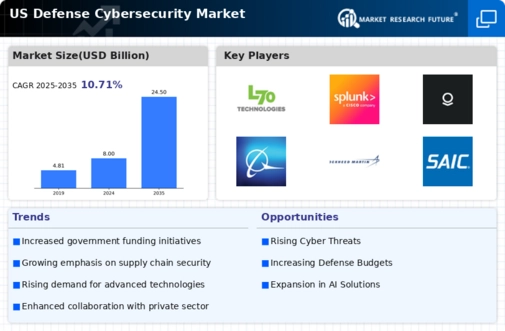The US Defense Cybersecurity Market has emerged as a critical sector driven by the increasing frequency and sophistication of cyber threats targeting national security. This market encompasses a broad range of technologies and services aimed at protecting defense networks, securing critical infrastructure, and ensuring the integrity of government data. As the demand for robust cybersecurity solutions grows, various players in this space are engaged in intense competition to develop innovative technologies, enhance their capabilities, and establish strong partnerships with government entities.
The landscape is characterized by a mix of established defense contractors, technology firms, and specialized cybersecurity providers, all striving to capture a share of this lucrative market. Emerging technologies such as artificial intelligence, machine learning, and cloud computing are reshaping the competitive dynamics, fostering an environment ripe for strategic investments and collaborations.L3 Technologies has developed a significant presence in the US Defense Cybersecurity Market, leveraging its extensive experience and technological expertise in defense and aerospace. The company’s strengths lie in its comprehensive portfolio of cybersecurity offerings that integrate advanced threat detection, incident response, and network security solutions.
L3 Technologies has focused on building strong relationships with key government agencies and military branches, which has allowed it to position itself as a trusted partner in safeguarding critical defense infrastructures. Its ability to provide customized solutions tailored to the unique needs of defense customers, along with a commitment to ongoing innovation in cybersecurity practices, adds to its competitive edge in the marketplace.
The company's established reputation results from years of effective defense contracts and a consistent commitment to maintaining advanced cybersecurity capabilities.Splunk operates within the US Defense Cybersecurity Market by offering powerfully integrated analytics and security solutions, the core of which includes its cutting-edge software designed for operational intelligence and data analysis. Its products enable various defense agencies to simplify their cybersecurity operations, enhance threat detection, and improve incident management through real-time data insights and analytics.
Strengths of Splunk in this sector are marked by its robust market presence and solid partnerships with key government entities, allowing it to effectively understand and address the dynamic needs of the defense industry. Splunk has pursued strategic mergers and acquisitions to augment its service offerings and broaden its technological capabilities, thereby enhancing its competitive standing. The company's commitment to innovation, along with a growing suite of services tailored specifically for the defense sector, has cemented its role as a vital player in the US Defense Cybersecurity Market, helping clients navigate the complexities of modern cybersecurity challenges.























Leave a Comment